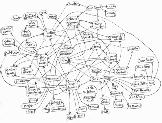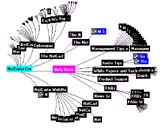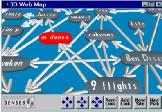Mapping the Web
(these notes were written around 1996-97)
 I want a program that will map the web in a
way that lets you fly around, getting an understanding of the relationships between sites.
I drew some clickable 2D maps by hand with pencil, scanned
them in and added hyperlinks. They give some feeling for what the more linked sites are
surrounding my site. With a map like this, a websurfer could jump ahead by several links
in any direction without waiting for the intermediate pages to load. I want a program that will map the web in a
way that lets you fly around, getting an understanding of the relationships between sites.
I drew some clickable 2D maps by hand with pencil, scanned
them in and added hyperlinks. They give some feeling for what the more linked sites are
surrounding my site. With a map like this, a websurfer could jump ahead by several links
in any direction without waiting for the intermediate pages to load.
When i revised the map to shows many more
links, it started to suffer from information overload.The links get crowded and tangled;
it's hard to see the immediate neighborhood for each site.
Existing programs
 In the public domain and commercial software worlds, the closest
thing i've found to a 3D web mapping program was WebSight from Fourth Planet - "a tool which utilizes
advanced visualization technology to effectively monitor and manage access patterns within
your web site in a manner that is visually intuitive." Unfortunately, it was under development but not very far along - it's no longer
mentioned on their website. It's not clear whether they would support true webs (as
opposed to simple heirarchies). One nice approach they took is using small literal images
to represent pages, as i did on one of my early
page designs. In the public domain and commercial software worlds, the closest
thing i've found to a 3D web mapping program was WebSight from Fourth Planet - "a tool which utilizes
advanced visualization technology to effectively monitor and manage access patterns within
your web site in a manner that is visually intuitive." Unfortunately, it was under development but not very far along - it's no longer
mentioned on their website. It's not clear whether they would support true webs (as
opposed to simple heirarchies). One nice approach they took is using small literal images
to represent pages, as i did on one of my early
page designs.
Also noteworthy was a product
called WebMapper from
NetCarta. (They got bought by Microsoft and the product
 got renamed
"Site Analyst", and buried in Microsoft's evil "Site Server"). It has a slick
"Cyberbolic" 2D view - unfortunately, it's really just a simple top-down
hierarchical graph which doesn't show the shape (topology) of the web at all. One useful
idea learned from WebMapper is: it may be beneficial to have the map change dynamically
depending on which site you're focused on. This could even be extended to a multi-site
selection - select a few sites and the map arranges itself to highlight connections
between those sites in the clearest possible way. got renamed
"Site Analyst", and buried in Microsoft's evil "Site Server"). It has a slick
"Cyberbolic" 2D view - unfortunately, it's really just a simple top-down
hierarchical graph which doesn't show the shape (topology) of the web at all. One useful
idea learned from WebMapper is: it may be beneficial to have the map change dynamically
depending on which site you're focused on. This could even be extended to a multi-site
selection - select a few sites and the map arranges itself to highlight connections
between those sites in the clearest possible way.
I've stopped trying to keep track of work in
this area, because it's maintained wonderfully by
the Atlas of
Cyberspaces. Visit
it today!
2D
For creating and maintaining 2D maps, i
could do it by hand if i had a program for drawing and editing 2D diagrams. These are the
options i've found:
Do it by hand, on paper. problem: takes
too long
Use the picture editor in MS Word.
problem: the arrows won't move with the boxes they're attached to.
Visio
4.0 appears to do diagrams intelligently. problem: costs $143.45 and might be a lot of
work to set up a "web-oriented" mode.
A full-featured structured drawing program
like Freehand or Illustrator. problem: probably overkill, and they're expensive, and i
don't have access to a copy of either.
Write a 2D mapping program myself. Hmmm.
If i'm gonna have to do it myself, i may as well use 3D..
3D
Perhaps using 3D might keep things from
being tangled visually. I created a proof-of-concept 3D mapping program using World Up - initially, just
arranging the objects and links in a 2D plane. Here is what my 3D
map looks like on a 2D plane. Since i've only implemented straight lines for links,
it's not terribly pretty, but i hope to get around to improving it soon.
Next step: Exploit the 3D medium by raising
and lowering sites. This could both de-tangle the connections, and let the user gain an
intuitive grasp of the topology of individual sites. This is only useful in a truly
realtime 3D system, because from each point of view some information would be obscured -
the user needs to move about smoothly to keep the spatial structure freshly imprinted in
their head.
Practical consideration: On an unaccelerated
P133, i got only 2-3 fps with the example map, so 3D acceleration hardware is
gonna be required.
Possibilities
In the future, the program could do the initial
mapping, instead of making the user surf manually and record the links they find, as it
does. This would require learning about some stuff like URLStream and Asynchronous
Monikers. Parsing the HTML should be the easy part since all you need to extract is the
URLs..
|


 In the public domain and commercial software worlds, the closest
thing i've found to a 3D web mapping program was WebSight from
In the public domain and commercial software worlds, the closest
thing i've found to a 3D web mapping program was WebSight from 
